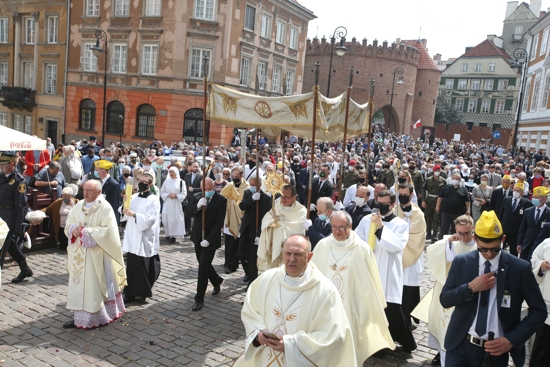
In Catholic Poland, Corpus Christi is more than a feast — it’s a nationwide act of faith.
On June 19, cities, towns and villages held solemn Eucharistic processions, publicly professing belief in Christ’s real presence in the Eucharist. The centuries-old tradition includes flower-strewn paths, children in white scattering petals and stops at four altars representing the Gospels.
“Corpus Christi” (“Body of Christ”) is the Latin name of the Solemnity of the Most Holy Body and Blood of Christ. It is one of the most important holidays in the liturgical calendar of the Catholic Church, during which the faithful publicly profess their faith in the real presence of Jesus Christ in the Eucharist. It is celebrated on the Thursday following the Trinity Sunday and in some countries — including the U.S. — on the Sunday following that feast.
The feast was established in 1264 by Pope Urban IV, and the first celebrations took place in Liège, now Belgium, where St. Juliana had a vision demanding a separate feast in honor of the Eucharist. In Poland, Corpus Christi has been celebrated since the 14th century and is exceptionally solemn.
The central point of the celebrations are Eucharistic processions, during which the faithful express their faith by following the Blessed Sacrament carried by a priest. In Poland, in centuries-old tradition, the procession is accompanied by the singing of Eucharistic hymns, children scattering flowers, and routes decorated with banners and colorful flower carpets.
“Parishioners lay them out as an expression of homage to Christ present in the host,” said Mariola Drapala, from Czestochowa, who was taking part in her parish procession this year, having walked the central procession in the city of the famed Black Madonna — 1 mile from the city’s cathedral to Jasna Góra Marian shrine — for over five decades.
“It’s a witness to faith that our parents passed to us, and we were trying to pass to our children, who were sometimes a bit grumpy because of the heat and tiredness, but it was important that they learn that faith needs to be joyfully manifested,” she told OSV News.
The procession stops at four altars, each symbolizing one of the four Gospels and serving as a station for contemplating the Word of God. It is also an image of the four corners of the world, to which Christ’s message is carried, as a sign of the universality of the Gospel and the presence of God among people.
Cardinal Grzegorz Rys of Lódz told OSV News that “the most beautiful image of the church is that we follow Jesus as his church and listen to his word.”
These four Corpus Christi altars, he said, “show the church following Jesus in order to listen, to listen to his word. The second important aspect of this special day is that when we listen, we are not to be closed off in the sacristy, in isolation. We are to have the courage to bear witness, and we are to do so with our own conviction.”
The cardinal said that “God — Jesus — is important hidden in the monstrance, and important in the community, the community of wandering people.”
St. Paul, the cardinal explained, in his First Letter to the Corinthians, “says that part (of him) belongs to the body of Christ in the Eucharist and (part) to the body of Christ, which is the church. Once a year, we can show ourselves with Jesus in public. So let’s go out!”
Father Eugeniusz Ploch of Holy Spirit Parish in Opole told OSV News as he prepared to march with his parishioners June 19: “This is a day that is a great opportunity to remind ourselves that God is truly present among us in the Eucharist, that he wants to be with us, where we are, in our everyday lives. Jesus says: ‘Give them something to eat.’ … I understand that in these words God is saying: ‘I need you!'”
Corpus Christi celebrations in many places in Poland attract crowds of the faithful — from children in first Communion outfits throwing flowers along the route of the Eucharistic procession to entire families and elderly people. In many places, the celebrations are particularly solemn, with the participation of orchestras, guards and local parish groups.
Other countries in Europe also celebrate with their own local processions.
Cardinal Rainer Maria Woelki of Cologne, Germany, is preparing his archdiocese for a special anniversary. In a pastoral letter published on June 17, he pointed out that the world’s first Corpus Christi procession took place in Cologne in 1279, and that the 750th anniversary this procession will be celebrated in 2029.
“For centuries, the feast of Corpus Christi has symbolized the fact that the Lord shares our lives with us and lives,” said Cardinal Woelki in his pastoral message on Corpus Christi. “He goes out from the churches to the people — especially to those who do not yet know Him and offers them His friendship.”




